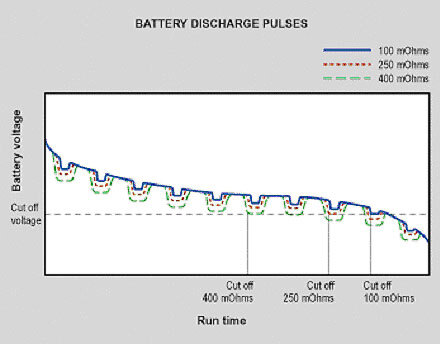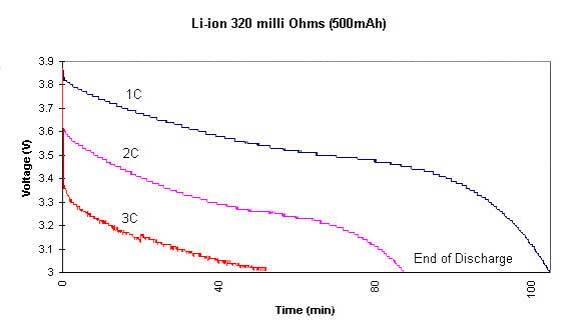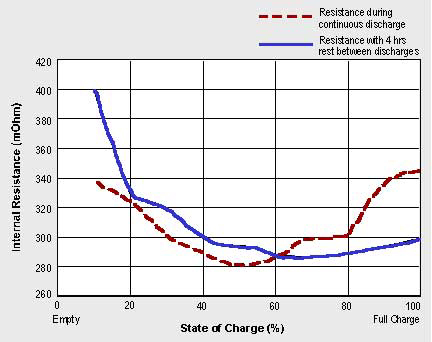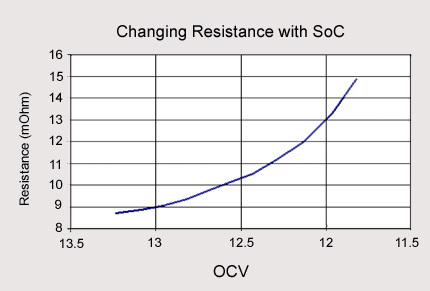With the move from analog to digital, new demands are placed on the battery. Unlike analog portable devices that draw a steady current, the digital equipment loads the battery with short, heavy current spikes.
One of the urgent requirements of a battery for digital applications is low internal resistance. Measured in milliohms, the internal resistance is the gatekeeper that, to a large extent, determines the runtime. The lower the resistance, the less restriction the battery encounters in delivering the needed power spikes. A high mW reading can trigger an early 'low battery' indication on a seemingly good battery because the available energy cannot be delivered in the required manner and remains in the battery
Figure 1 demonstrates the voltage signature and corresponding runtime of a battery with low, medium and high internal resistance when connected to a digital load. Similar to a soft ball that easily deforms when squeezed, the voltage of a battery with high internal resistance modulates the supply voltage and leaves dips, reflecting the load pulses. These pulses push the voltage towards the end-of-discharge line, resulting in a premature cut-off. As seen in the chart, the internal resistance governs much of the runtime.

Talk-time as a function of internal resistance
As part of ongoing research to measure the runtime of batteries with various internal resistance levels, Cadex Electronics examined several cell phone batteries that had been in service for a while. All batteries were similar in size and generated good capacity readings when checked with a battery analyzer under a steady discharge load. The nickel-cadmium pack produced a capacity of 113%, nickel-metal-hydride checked in at 107% and the lithium-ion provided 94%. The internal resistance varied widely and measured a low 155 mOhm for nickel-cadmium, a high 778 mOhm for nickel-metal-hydride and a moderate 320 mOhm for lithium-ion. These internal resistance readings are typical of aging batteries with these chemistries.
Let's now check how the test batteries perform on a cell phone. The maximum pulse current of a GSM (Global System for Mobile Communications) cell phones is 2.5 amperes. This represents a large current from a relatively small battery of about 800 milliampere (mAh) hours. A current pulse of 2.4 amperes from an 800 mAh battery, for example, correspond to a C-rate of 3C. This is three times the current rating of the battery. Such high current pulses can only be delivered if the internal battery resistance is low.
Figures 2, 3 and 4 reveal the talk time of the three batteries under a simulated GSM current of 1C, 2C and 3C. One can see a direct relationship between the battery's internal resistance and the talk time. nickel-cadmium performed best under the circumstances and provided a talk time of 120 minutes at a 3C discharge (orange line). nickel-metal-hydride performed only at 1C (blue line) and failed at 3C. lithium-ion allowed a moderate 50 minutes talk time at 3C.



Internal resistance as a function of state-of-charge
The internal resistance varies with the state-of-charge of the battery. The largest changes are noticeable on nickel-based batteries. In Figure 5, we observe the internal resistance of nickel-metal-hydride when empty, during charge, at full charge and after a 4-hour rest period.
The resistance levels are highest at low state-of-charge and immediately after charging. Contrary to popular belief, the best battery performance is not achieved immediately after a full charge but following a rest period of a few hours. During discharge, the internal battery resistance decreases, reaches the lowest point at half charge and starts creeping up again (dotted line).

The internal resistance of lithium-ion is fairly flat from empty to full charge. The battery decreases asymptotically from 270 mW at 0% to 250 mW at 70% state-of-charge. The largest changes occur between 0% and 30% SoC.
The resistance of lead acid goes up with discharge. This change is caused by the decrease of the specific gravity, a depletion of the electrolyte as it becomes more watery. The resistance increase is almost linear with the decrease of the specific gravity. A rest of a few hours will partially restore the battery as the sulphate ions can replenish themselves. The resistance change between full charge and discharge is about 40%. Cold temperature increases the internal resistance on all batteries and adds about 50% between +30°C and -18°C to lead acid batteries. Figure 6 reveals the increase of the internal resistance of a gelled lead acid battery used for wheelchairs.

Source: Cadex battery laboratories.

Comments
Looking for comments from the previous website?
Comments from the previous website are not compatible with our new commenting system but we have preserved them so our users can still reference and make use the information in them.

Would it be possible to send short 1 second current bursts at C/4 and then switch off the charge current for 0,1 sec during which I measure the true internal cell voltage without any current flow through the internal resistance interfering with the true internal voltage reading of the cell. If this voltage reads 4,1 volts or whatever the terminal voltage is needed then the current bursts stop. In this way I see it should be possible to charge the cell faster without the internal resistance causing the charging current to taper off at the end. As you know most common chargers have a set end voltage which is the reason for the tapering charge current. Using the pulse charging method I do realise that with the internal resistance, the voltage across the cell will end up higher than the 4,1 volts especially with an old cell or low quality cell of high internal resistance. This is due to the same C/4 current across the internal resistance causing a voltage drop internally plus the true internal cell voltage. The question is, will it be safe as the true internal voltage of the cell will still be below the 4,1 volt until the off charge voltage measures 4,1 volts which is where it stops charging. In my tests I have seen voltages of 4,7 volts in the 1 sec bursts due to the poor cells tested on, yet the terminal off charge voltage it 4,1 volts. The circuit works and none of the cells have blown up so far but my question is am I being dangerous?